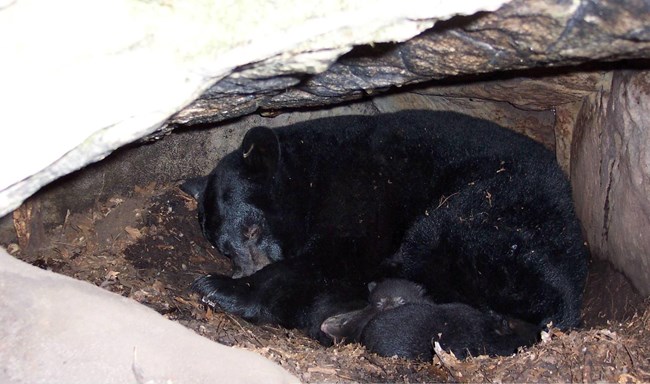

Left image
Credit: NPS
Right image
Credit: NPS / Neal Herbert
Image: black bear in a forest
Text 1: slide for Quick Facts Black Bear
Text 2: Quick Facts Black Bear
-
Height: About 3 feet at the shoulder and 5-7 feet when standing upright
-
Weight: Ranges from 100 to 600 pounds depending on age, sex, and season
-
Average Life Span: 15-25 years
-
Did You Know? Despite their name, black bears can be black, cinnamon, blonde, blue/gray, or even white!
American black bears (Ursus americanus) are the most common and widely distributed species of bears in North America. They can be found anywhere from forested areas to the beach to the alpine zone.
While bears of the same species might look similar, everything from their size, coloring, diet, and sleeping patterns depend on the bear and its location. For example, a bear’s diet varies depending on what foods are available during a specific season in a specific region. The home range for an adult black bear can vary depending on the location, season, and food availability.
Let’s take a look at two different black bears, one in Great Smoky Mountains National Park and another in Glacier Bay National Park and Preserve to see how they differ in diet, winter denning, and life cycle. For more information about bears and bear behavior in a specific national park, please contact that park.
What Do Black Bears Eat?

Black bears will eat almost anything. They are omnivores, meaning that they eat both plants and animals. Their curved claws help them climb trees to search for food, but they cannot dig for food as well as a brown bear. Black bears are very smart and can identify food not only by smell but also by appearance.
Bears who have been fed human food will begin to associate campsites, bags, garbage cans, and even cars with food. These food-conditioned bears can become dangerous. So please remember: Don’t let bears get your food or garbage! Help keep them wild by following these tips on food storage and bear safety.
Black Bear in Great Smoky Mountains
Black bears are one of the largest predators living in Great Smoky Mountains National Park, but the majority of their diet is made up of plants. Eighty-five percent of a Great Smoky Mountains black bear’s diet comes from berries and nuts. Black bears in the Great Smoky Mountains also eat insects and animal carcasses when they are available.
Black Bear in Glacier Bay
Black bears in Glacier Bay eat a wide variety of plant and animal foods. They often graze on shoreline grasses and sedges, dandelions, wild celery, cow parsnip, and other beach and meadow plants. They use their long claws to dig up plants and roots and to pick ripened berries in the summer. In the late summer and fall, black bears eat salmon from the large streams of Alaska. Occasionally, black bears will eat other animals including bumblebees, birds, bird eggs, rodents, and animal or whale carcasses.

Winter Dens
Black Bear in Great Smoky Mountains
Bears in the Great Smokies will den during the winter to escape the cold weather. While some bears den in hollow stumps and tree cavities, these bears are unusual in that they often den high above ground in standing hollow trees. It is believed that these black bears do not enter a true hibernation, and they may leave their den for short periods of time if the weather is warm or if they are disturbed.
During the winter denning period, pregnant black bears will give birth to cubs. Bears without cubs emerge in the early spring; mother bears and cubs emerge last usually in late March or early April.
Black Bear in Glacier Bay
Like the ones at Great Smoky Mountains, black bears in Glacier Bay enter dens during the winter if there is little to no food available. Black bears in Alaska will make their dens in the snow, under root structures, or in caves.
In colder parts of Alaska, black bears will hibernate for about seven months. Bears along the warmer coast may hibernate for only two to five months, or not at all.
Just like their Great Smoky Mountains counterparts, pregnant black bears in Glacier Bay give birth to their cubs in their dens. Cubs are usually born within the first two months of hibernation. Cubs and their mothers stay in their dens for the rest of the winter while the mother bear rests and the cubs nurse and grow. Females and their cubs usually emerge from their winter dens in late March or early April.
Life Cycle

NPS Photo
For the most part, adult black bears lead solitary lives, except when mating season takes place. Black bear mating season occurs during the summer, but the embryos do not begin to develop until the mother bear enters her den. Cubs are born in the middle of the winter denning period, usually between mid-January and early February.
Cubs are born tiny, helpless, and hairless, weighing less than half a pound. A mother bear will typically give birth to one to three cubs at a time. By the time a mother bear and her cubs are ready to emerge into spring, the cubs typically weigh around five pounds.Young bears grow very quickly and can weigh around 80 pounds by their first birthdays. Cubs will remain with their mother for about 18 months or until she is ready to mate again.
Last updated: November 5, 2024
